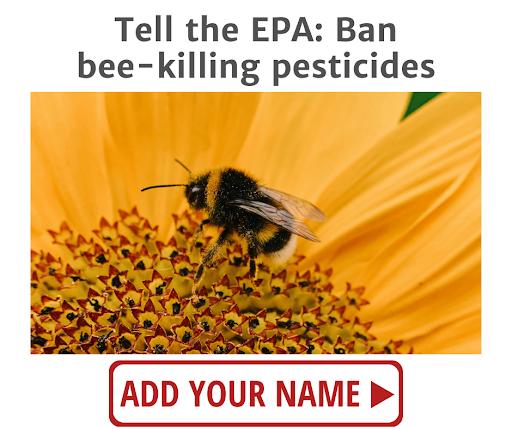
 |
John,
Did you know that American bumblebees have completely disappeared from 8 states?1
They're not the only bee species in trouble -- the rusty patched bumblebee, the Western bumblebee and more are also in peril. The latest count on honeybees shows record losses, with 48% of colonies dying off in just one year.2
Bees pollinate 70 of the 100 crops that provide 90% of the world's food. So when we see record losses for bees, we're really seeing record losses for our food system.
The consequences of these record die-offs are profound, but the solution is simple: We need the Environmental Protection Agency (EPA) to ban the worst uses of bee-killing pesticides. Will you call on the EPA to save our food and our best pollinators today?
"Colony collapse disorder." If it sounds bad, well, that's because it is.
When bees are inundated with killer pesticides like neonicotinoids -- more commonly known as neonics -- their nervous systems, navigation, and immune systems are impaired. These poisons make them more susceptible to disease, disappearance, or death.3
And when worker bees die or disappear from a hive, we get colony collapse disorder. The site where worker bees used to recharge after pollinating 80% of flowering plants eventually becomes a wasteland -- kind of like our grocery stores without bees.
We have bees to thank for everything from apples to zucchini. At PIRG, we think that dumping 4 million pounds of bee-killing pesticides every year is no way to say thank you.4
Are you with us?
Call on the EPA to save bees and our food by banning the worst uses of bee-killing pesticides.
The nastiest thing about neonics -- and there are plenty -- is that they don't go away after one spray or seed coating.
Neonics, in all their toxicity, accumulate over time and continue to leak bee poison into the environment for years after initial use.5
For the future of our food system, it's time to turn off the tap and pull our best pollinators back from the brink.
Tell the EPA to ban the worst uses of neonics today.
Thank you,
Faye Park
President
1. Steve Blackledge, "The American bumblebee is on the decline," Environment America, January 24, 2022.
2. "US honeybees suffer second deadliest season on record," The Guardian, June 23, 2023.
3. Chris Slay, "The buzzing crisis: Honey bees and pesticides," The Tomahawk, September 15, 2023.
4. Andria M. Cimino, Abee L. Boyles, Kristina A. Thayer, Melissa J. Perry, "Effects of Neonicotinoid Pesticide Exposure on Human Health: A Systematic Review," Environmental Health Perspectives, February 2017.
5. Thomas James Wood and Dave Goulson, "The environmental risks of neonicotinoid pesticides: a review of the evidence post 2013," Environmental Science and Pollution Research International, June 7, 2017.
Support U.S. PIRG. Contributions by people just like you make our advocacy possible. Your contribution supports a staff of organizers, attorneys, scientists and other professionals who monitor government and corporate decisions and advocate on the public's behalf.
Join us on Facebook | Follow us on Twitter
U.S. PIRG, Main Office: 1543 Wazee St., Suite 460, Denver, CO 80202, (303) 801-0582
Federal Advocacy Office: 600 Pennsylvania Ave. SE, 4th Fl., Washington, DC 20003, (202) 546-9707
Member Questions or Requests: 1-800-838-6554.
If you want us to stop sending you email then follow this link -- unsubscribe.